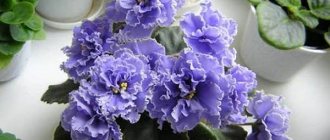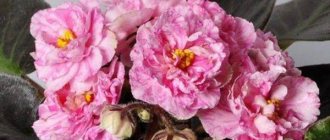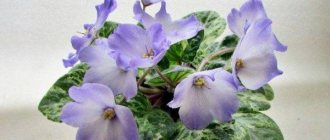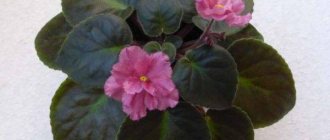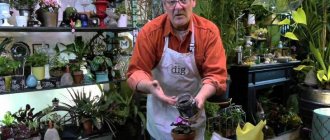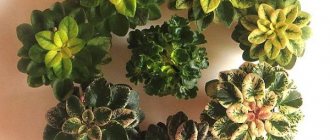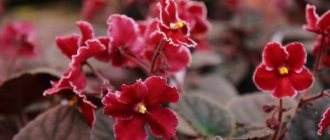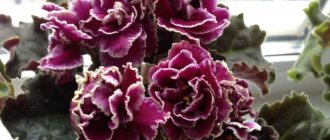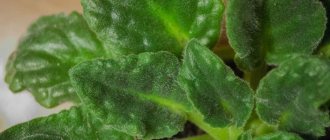The richest flow of colors and model configurations of Saintpaulia varieties registered by foreign breeding masters would be incomplete without retro varieties, which include violets Ruffled Skies and Ruffled Skies 2 (K.Stork/G.Boone).
Thanks to the time-tested sophistication of flowering and the pompous majesty of the images, as well as because of their self-sufficiency during development, both violets can still arouse the genuine interest of gardeners and are worthy of taking the best places on the shelves of collections.
History of the creation of varieties
The described violets, which bring colorful animation to all the orderly rows of collection specimens, were obtained by the promoter of pelargoniums and Usambara violets, an internationally recognized master of breeding art from Iowa, USA, Gordon Boone (G. Boone).
But for registration in the lists of AVSA, the most important organization of American violet growers, the varieties were presented by K. Stork , and therefore have dual authorship (K. Stork / G. Boone).
Gordon's passion for plants began in childhood, when he, helping his father, worked in a small nursery in his hometown.
Boone spent his early years in Canada - it was there that he really became involved in working with flowers, first with pelargoniums and then with violets.
He became involved in the selection of Saintpaulias thanks to his acquaintance with the master of violet breeding, Ernest Fischer , and gradually began to be considered a genius in his field.
At the end of the 70s, G. Boon returned to his homeland, continuing to work on improving the qualities and images of violets. But, unfortunately, flower growers have become acquainted with only a small fraction of them.
Reviews
Natalya Borisovna. “A classic in the world of violets, created by the wonderful breeders B. and T. Makuni. Many works of these great people have won my heart. The collection consists of 18 works by these masters. An important place in it is occupied by the “Favorite Daughter” variety. The variety is easy to care for and produces many children when propagated. During their first blooms, the flower stalks lie on the rosette, but this does not spoil the appearance of the plant at all. I’ve been growing it for many years, I’ve given it to friends, and I’ve never regretted purchasing this variety.”
Flower growers leave only positive reviews about the variety.
Alina. “Everyone writes that this is a retro variety, that it is very old and there are more worthy varieties, but I like it so much that I don’t even think about replacing it. Look at what an amazing, not pretentious coloring, with curly pansies of lilac-violet color. How a thin ink border ennobles every ruffle. Isn't this a miracle? This variety does not require any difficulty in care, especially watering, as it can tolerate a day. I recommend it to all lovers of home gardening.”
Violet "Ruffled Skies"
This section presents photos and descriptions of the Ruffled Skies violet variety. This magnificently airy variety has become familiar to flower growers since 1992.
Description of the variety
This incredibly delicate vintage beauty is distinguished by its classic format , which varies upward among the most diligent flower growers and reaches the scale of large subspecies.
After independently entering the stage of an adult plant, Saintpaulia is a neat, strictly rationally arranged bush, overflowing with leaves to the compacted texture of a tiled silhouette.
NOTABLE! Over time, the rosette develops a configuration with compact, sharpened silhouette boundaries, but it is possible to create a hemispherical shape by bending the leaf plates to the flowerpot.
The medium-sized leaves in the texture of a broadly constructed oval are distinguished by the volumetric quilting of the textured-dusty layer, well-cut teeth along the edge in the form of relief curves, and a graphically symmetrical pattern of venation.
They also stand out for their attention-grabbing clear structural pattern and bright emerald hue , as well as the dark color of the malachite plates, which sometimes want to take on a wavy configuration or hug a flowerpot.
At first, the budding of the variety . By the third flowering, the violet creates an outstanding volume of frilly caps from large-sized “star” corollas with a terry-textured structure, whose petals are characterized by significant undulation and abundant corrugation of the edges.
The tonal color palette of the corollas of the vintage variety combines the changeable nuances of the bluish-blue spectrum with lilac tints and the white color of rich lace along the frilly contour of the petals .
The boundaries of the edging flow in watercolor into the main tone of the flower, without a clear structure and continuity.
Sports
Violet Rufled Skyes can sport, forming variations:
- with excessively double flowers of darker shades with a green edging fringe - “Ruffled Skies-2” ;
- with a variegated rosette of pink and beige shades;
- with white corollas in a greenish outline and a semi-miniature bush - CM-Mont Plaisir or Saint-Petersburg Sky .
Features of development and flowering
Flower growers the lovely retro-varietal violet for its outstanding decorative effect, the absence of unnecessary hassle due to the plant’s independence and the presence of a minimum of unexpected pitfalls.
Growth in apartment collections
The interest of violet growers in the vintage variety of violets is due to the unpretentiousness of the specimens and modest character. Special touches may be noted:
- the ability to successfully self-form neat forms of rosettes;
- luxuriously tight silhouette configurations;
- the exceptional significance of the flower caps;
- a calm attitude towards the lack of light;
- continuous frequency of flowering.
The complicated strokes of Saintpaulia include:
- lengthening of peduncles under lamp lighting;
- inexpressive first flowering;
- instability of decorative color waves;
- bending leaves to the flowerpot.
Breeding feature
ATTENTION! Problem-free propagation of the variety is ensured by easy pinching and excellent pecking of a mass of well-developing children.
Temperature and flowering
The hot conditions of apartment collections negate the decoration of the corollas in the form of a white border. The decorative appearance of flowers is preserved better in cool conditions.
The variety bears many buds on persistent pedicels of slightly oversized size.
The presented variety is characterized by the creation of magnificent caps from the third round of budding.
The corollas of the vintage violet variety exhibit healthy decorativeness and freshness for more than one and a half months.
Reviews
Galina Ivanovna. “Violet Ruffled Skies is a chic retro variety. It's almost thirty years old and better than many modern options. For so long, I haven’t changed my qualities one iota.”
Disease and pest control
If all the rules for growing violets are not followed, they can be affected by the following pests and diseases:
- Powdery mildew. This is a fungal disease, which can be recognized by the presence of whitish spots on the leaves of the plant. You can fight it with the help of Fundazol.
- Late blight. This is a serious disease, when it develops, remove all affected plants and disinfect the pot. The disease can be propagated by the presence of brown spots on the foliage, as a result of which the root system rots.
Gray rot. The main symptom of this disease remains gray spots in any area. As soon as they have been discovered, remove them and transplant the flower itself into a clean substrate. Treat the plant itself with a fungicide.- Rust. This is a disease that can be recognized by the presence of brownish-orange spots on the leaves. To combat the disease, use a weak solution of copper sulfate.
- Ticks. These pests are frequent visitors to violets. They can be identified by the presence of cobwebs and eaten marks. An acaricide is used to treat the plant.
- Shield. This pest can be recognized by specific wild spots on the leaves. Processing is carried out using Agravertine.
- Thrips. This parasite harms the entire plant. If thrips are detected, you need to cut off all the flowers and treat the violet itself with Aktara.
Violet Greenhouse effect is an ornamental plant that is valued for its unusual appearance. In terms of care, the flower is not picky, although it needs to follow simple agrotechnical rules. Growing this variety is so simple and easy that even inexperienced gardeners can choose it.
Violet “Ruffled Skies 2”
Below you will find a photo and description of the violet Ruffled Skies 2, which is a sport from the violet “Ruffled Skies” and is not listed in the official registers either as an independent variety or as a sports specimen.
INTERESTING! The number “2” was introduced into the name by Russian flower growers to distinguish violets.
Description
Young bushes of sporting violets are self-sufficient varieties that easily, without additional support from the violet grower, create the structure of a problem-free curly rosette from the entire volume of growing leaves.
The bush is formed as a neat standard , not changing its optimal size too often. But the development of the variety is carried out very measuredly.
Large-format leaves of an oval-wavy model with a slightly glossy textured quilting of the top layer have a slightly shaggy, multidirectional serration of the outline and strong curling of the edges, which leads to some chaoticness of the leaf mass .
The color of the upper part of the leaf is distinguished by notes of dark grass, the color of the lower side has a spray of reddish-burgundy tint.
Varietal flowers of quite significant parameters are painted in colorful colors of bluish-blue with cornflower blue reflections; the reverse side of the petals of many bushes is distinguished by a whitish coating.
In violets, a special nuance of the “star” corollas is considered to be the incomprehensibly terry structure of their assembly and the decoration of the petals with a light venous pattern .
The petals at the same time stand out with wavy edges. Their rich volume is noticeably increased due to the abundant corrugation and edging braid of a greenish color of varying saturation.
Sports
The violet's ability to form sporting bushes has not been noticed .
Features of variety development
Flower growers, when keeping intricately blooming violets in their collections, do not complain about the behavior of specimens of the tropical plant, since they have excellent independence and do not create unpleasant surprises.
Violet Ruffled Skies-2 shows an absolute lack of pickiness , integrates into the room microclimate system without any nuances, and blooms vigorously with remarkably large flowers of original color and texture.
The only important drawback is the extremely slow development of the bushes.
Saintpaulia can be propagated only by vegetative methods.
Bloom
The buds of the variety are supported by strong peduncles of a slightly large size.
The described variation of Saintpaulia does not immediately show the majestic forms of flower caps.
CAREFULLY! In hot microclimates, the green edge of the petals greatly reduces their volume.
Flowers of the variable variety remain in their original state for about a month and a half.
Reviews
Milana. "Showy, large-flowered specimens of Saintpaulia 'Ruffled Skies-2' give the impression of rich Venetian carnival costumes."
Description of Saintpaulia
We love violets for their miniature size and the fact that they can bloom for 10 months a year . The leaves of the home violet are collected in a basal rosette, round in shape, fleshy, covered with villi and have smooth or slightly jagged edges, depending on the variety. The color may be dark green, green, or spotted.
The flowers have five smooth or double petals, their color varies from lilac, blue to red, burgundy, white, yellow, and their size is from two to four cm. There are flowers of different colors. The root system of the Uzambara violet has a superficial structure.
Caring for violets in a home microclimate
Specimens of varietal varieties of violets in indoor gatherings demonstrate a very problem-free nature:
- that are most beneficial for violets are those that are located on the southeast side - here the plants are most illuminated. The windows on the south side of the house are better illuminated in winter, but in summer severe overheating is noticeable there, which threatens the plants with burns.
Therefore, it is recommended to slightly shade the windows during midday heat. Window sills in the eastern and western directions are considered semi-shaded; here the sun's rays are available to violets only in the first half of the day. Northern windows are the worst suited for placing violets, and then only if they are equipped with additional lighting;
- watering should not be carried out too often while simultaneously monitoring the drying of the top layer of the substrate in the flowerpot;
- additional nutrition with mineral fertilizers at a particular moment in time or not, showing their internal state with a decorative appearance.
In the same way, you can find out the plant’s need for certain types of fertilizers. But this procedure of agrotechnical care cannot be abused; - An important role in all life processes of specimens of the variety is played by the optimal lighting regime with a well-chosen structure. For proper growth and healthy flowering, it is necessary to combine long-term illumination of the plant with a natural spectrum with exposure to LED lighting;
- the possible temperature gradient is +20 + 24°C. It is important to prevent its extraordinary jumps and cold drafts;
- timely provision of violets in the home collection with fresh substrate is a necessary condition for maintaining the health of the specimen - this will ensure aeration and water permeability of the soil. In addition, a good drainage system is needed;
- For replanting, it is more correct to use “transshipment”, although it is suitable when working only with healthy violets.
Reproduction methods
At home, propagation by leaf cuttings . This method of vegetative propagation is reliable and simple.
This violet reproduces by leaf.
